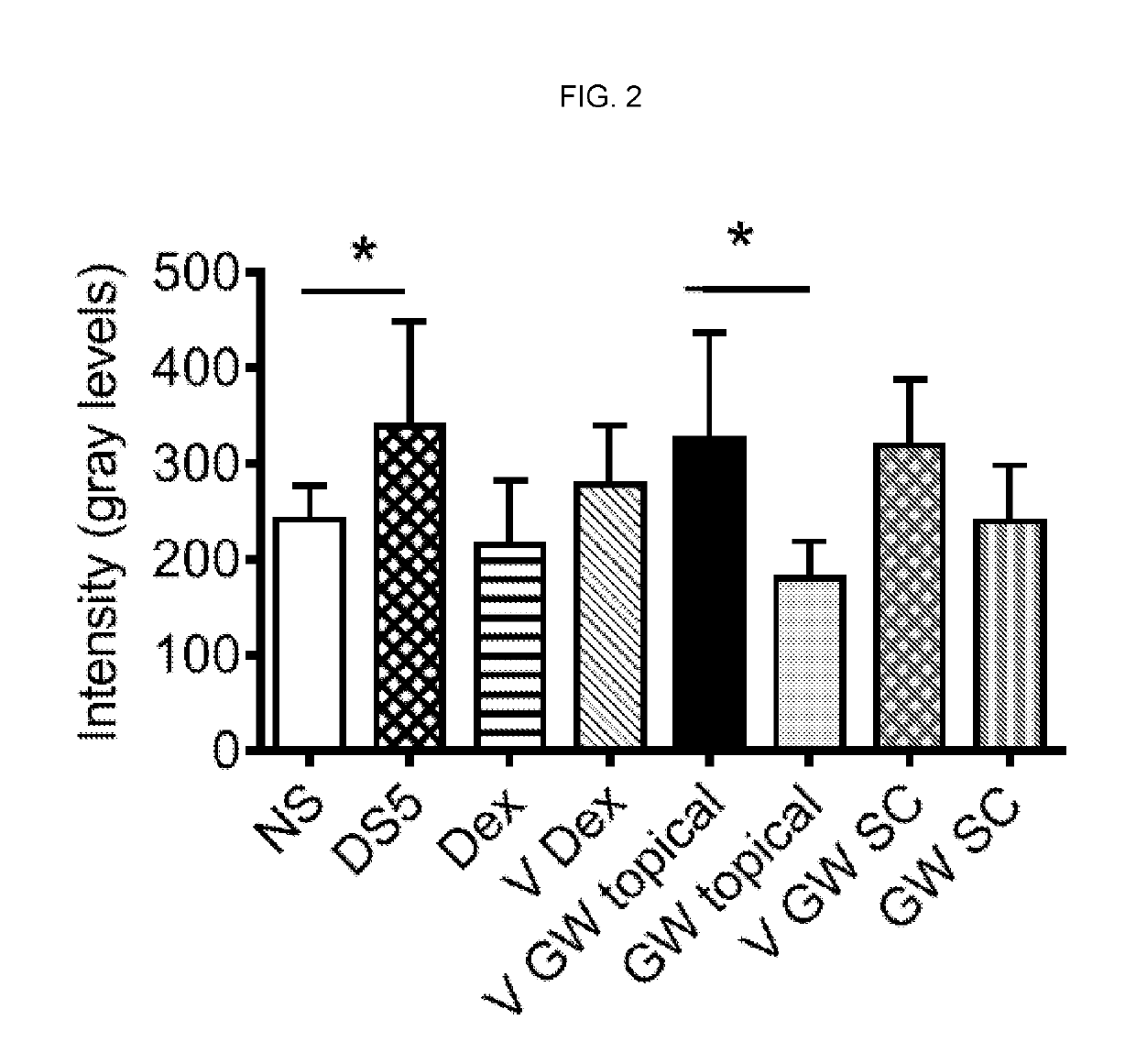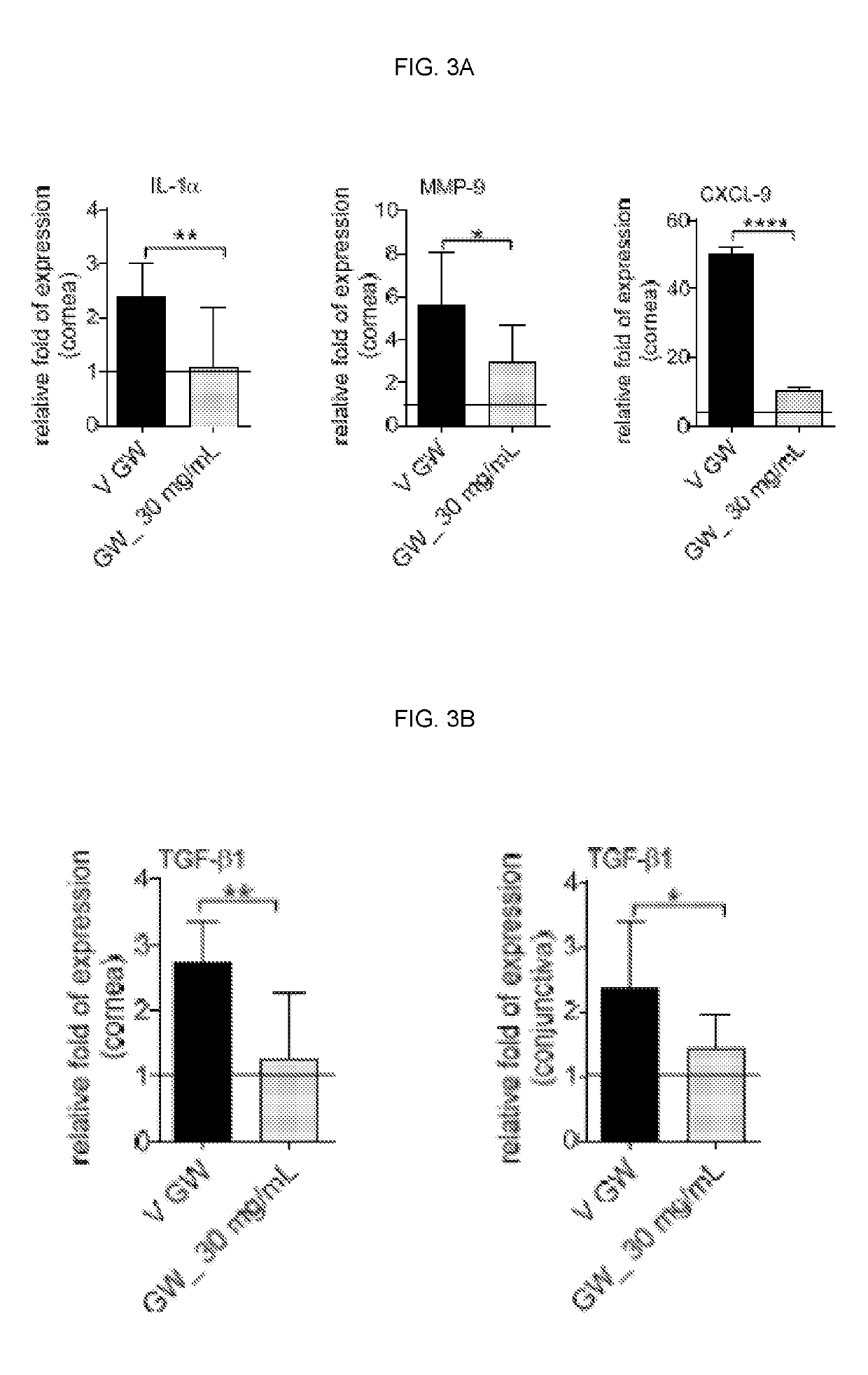Pharmaceutical compositions comprising an integrin ALPHA4 antagonist for use in treating ocular inflammatory conditions
a technology of ocular inflammatory conditions and pharmaceutical compositions, which is applied in the direction of drug compositions, heterocyclic compound active ingredients, and aerosol delivery, can solve problems such as tear film abnormalities, and achieve the effects of improving corneal epithelial barrier function, reducing inflammatory markers, and reducing recruitment and homing of t lymphocytes
- Summary
- Abstract
- Description
- Claims
- Application Information
AI Technical Summary
Benefits of technology
Problems solved by technology
Method used
Image
Examples
example 1
ogy of GW559090
[0127][3H]GW559090 binding to human J6 cells was saturable and was described in these experiments by a single binding site with mean Kd of 0.19 nM (0.08-0.43) (geometric mean and 95% CL) derived from 4 separate experiments. A single high affinity binding site for [3H] GW559090 was also shown in rat RBL-2H3 cells which express rat α4β1, mean Kd 1.04 nM (0.58-1.89).
[0128]Inhibition of cell adhesion was determined for α4β1 (Jurkat J6 cells) to VCAM-1 and CS-1 (fibronectin domain); for α4β7 (RPMI 8866 cells) to MAdCAM in coated microtiter plates. GW559090 inhibited J6 cell adhesion to VCAM-1 in a monophasic fashion with a mean IC50 of 7.72 nM (2.39-24.9). GW559090 also inhibited J6 cell adhesion to CS-1 with a mean IC50 of 8.04 nM (3.05-21.2) and to MAdCAM in a biphasic manner, supporting the presence of a high and low affinity site for MAdCAM-GW559090 binding in J6 cells. The RPMI 8866 MAdCAM binding predominantly measures α4β7 mediated cell adhesion. GW559090 inhibited ...
example 2
reatment with the Compound of Formula I Prevents Desiccation-Induced Corneal Barrier Disruption
[0131]We found a significant increase in corneal permeability measured by OGD staining between the untreated non-stressed (NS) and dry eye control groups (DS5, FIG. 1). Because corticosteroid therapy has been reported to improve corneal epithelial disease of dry eye both in humans and mice (de Paiva et al., 2006a; de Paiva et al., 2006b; Marsh and Pflugfelder, 1999), we used topical treatment with Dexamethasone (Dex) as positive control. Treatment with 0.1% Dex significantly improved OGD intensity scores. A range of doses of the compound of formula I, as low as 1 mg / mL and as high as 30 mg / mL, was investigated. A significant decrease in OGD intensity scores was noted with increasing concentrations of the compound of formula I vs. its vehicle. The most efficacious concentration was 30 mg / mL (FIG. 1) which was therefore used in subsequent studies.
example 3
und of Formula I Acts Topically on the Ocular Surface
[0132]To explore the effect of systemic administration of the compound of formula I on corneal staining, two routes of administration, topical and subcutaneous (SC), were compared. An identical dose was given SC (120 μg as one 4 μL bolus) and topically (60 μg as a 2 μL drop to each eye). Mice receiving the compound of formula I systemically were also given vehicle eye drops topically. As shown in FIG. 2, and similar to FIG. 1, topical dexamethasone decreased OGD uptake. Topical treatment with the compound of formula I again significantly decreased DS-induced corneal barrier disruption compared to its vehicle. This effect was not observed when the compound of formula I was administered systemically. These results indicate that the local therapeutic effect of the compound of formula I is achieved by topical administration as traditional eye drops. This represents a surprising finding given the known role of integrins in leukocyte tr...
PUM
| Property | Measurement | Unit |
|---|---|---|
| volume | aaaaa | aaaaa |
| volume | aaaaa | aaaaa |
| pH | aaaaa | aaaaa |
Abstract
Description
Claims
Application Information
 Login to View More
Login to View More - R&D
- Intellectual Property
- Life Sciences
- Materials
- Tech Scout
- Unparalleled Data Quality
- Higher Quality Content
- 60% Fewer Hallucinations
Browse by: Latest US Patents, China's latest patents, Technical Efficacy Thesaurus, Application Domain, Technology Topic, Popular Technical Reports.
© 2025 PatSnap. All rights reserved.Legal|Privacy policy|Modern Slavery Act Transparency Statement|Sitemap|About US| Contact US: help@patsnap.com



